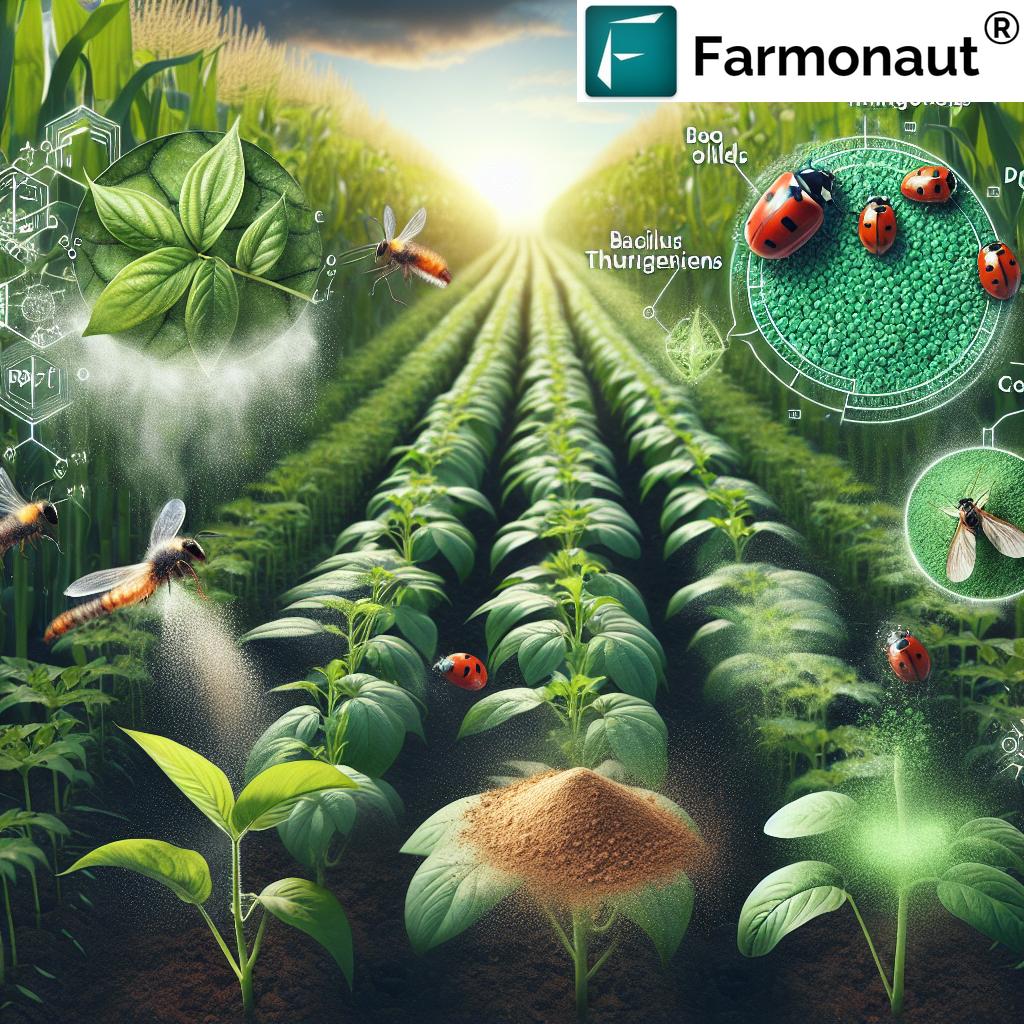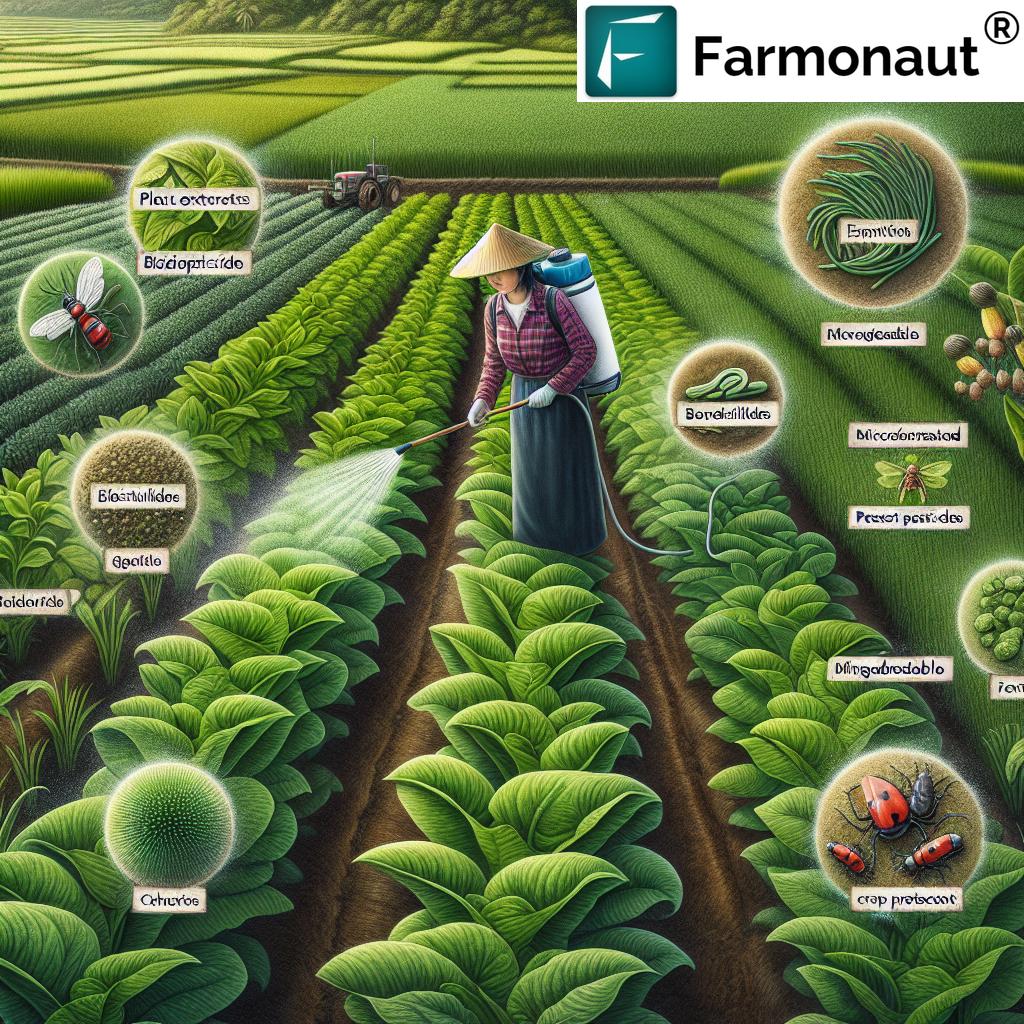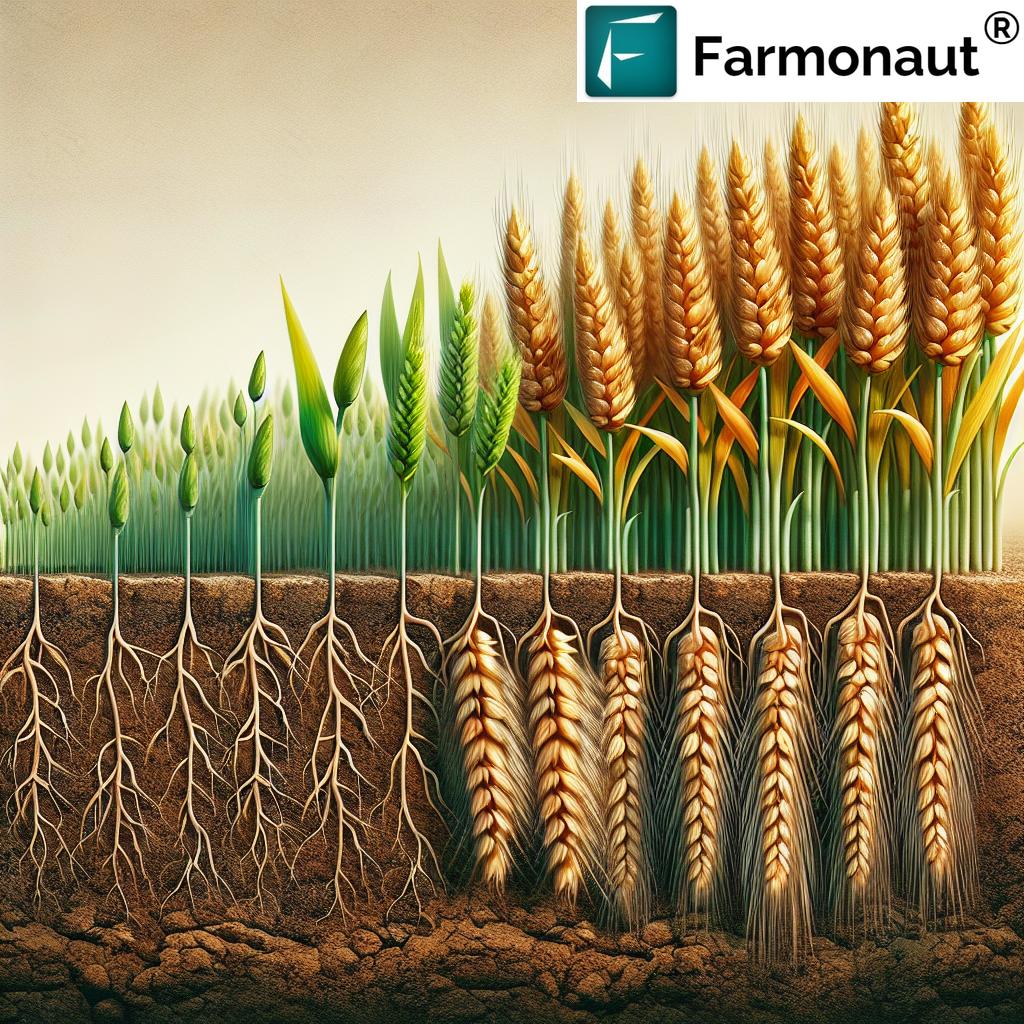7 Sustainable Crop Protection Ingredients You Need Now
Table of Contents
- Introduction: Why Sustainable Crop Protection Matters
- 1. Biopesticides: Harnessing Nature’s Defenses
- 2. Plant Extracts: Natural Pest Control Agents
- 3. Biostimulants: Enhancing Plant Resilience
- 4. Pheromones: Disrupting Pest Reproduction
- 5. Microbial Products: Biological Control Agents
- 6. Biodegradable Delivery Systems: Precision and Sustainability
- 7. Integrated Pest Management (IPM): A Holistic Approach
- Comparison Table: 7 Sustainable Crop Protection Ingredients
- Enabling Sustainability with Farmonaut Technologies
- Challenges and The Future of Sustainable Crop Protection
- Farmonaut Subscription Plans
- FAQs: Sustainable Crop Protection
- Conclusion
Sustainable Crop Protection: Why It’s More Critical Than Ever
As we face escalating challenges due to climate change, pest resistance, and dwindling biodiversity, sustainable crop protection becomes not just an environmental consideration but a strategic necessity for modern agriculture.
Our core mission as agricultural stewards should center around safeguarding crops from pests and diseases while minimizing negative environmental impact, enhancing crop health, and supporting long-term ecological balance.
Traditional chemical pesticides—though effective—are often associated with toxicity, environmental persistence, and the loss of agricultural biodiversity. In response, an urgent, growing emphasis is placed on transitioning to sustainable crop protection ingredients that are effective, environmentally responsible, and fully compatible with integrated pest management (IPM) strategies.
In this comprehensive guide, we’ll explore seven essential sustainable crop protection ingredients you need now. We’ll discuss their science, applications, the benefits for both crops and our environment, and how you can leverage Farmonaut’s technology to monitor crop health and practice sustainability in farming. Along the way, we’ll focus on sustainable solutions like biopesticides for pest control, biostimulants in agriculture, plant extracts for pest management, and the use of biodegradable crop protection systems.
1. Biopesticides: Harnessing Nature’s Defenses for Sustainable Crop Protection
What are Biopesticides?
Biopesticides are naturally derived substances or living organisms that protect crops by controlling pests and diseases in an environmentally friendly way. They consist of:
- Microbial pesticides: Utilizing bacteria, fungi, or viruses that specifically target pest insects or pathogenic fungi.
- Plant-incorporated protectants: Inherent resistance embedded at the genetic level in plants through selective breeding or biotechnology.
- Biochemical pesticides: Natural compounds occurring in nature that repel pests or disrupt their life cycles, without being directly toxic.
How Do Biopesticides Work?
Biopesticides for pest control act through unique mechanisms:
– Microbial pesticides (e.g., Bacillus thuringiensis, known as Bt) produce specific toxins that are lethal only to specific insect species.
– Biochemical pesticides may disrupt mating behaviors (like pheromones), repel pest insects or inhibit their feeding.
Unlike most traditional chemical pesticides, these agents target a narrow spectrum of pests, leaving beneficial organisms like bees, butterflies, and earthworms unharmed and preserving biodiversity.
Examples
- Bt (Bacillus thuringiensis): Used to control caterpillar pests on crops like corn, cotton, and vegetables. Harmless to humans and pollinators.
- Trichoderma spp.: Fungi effective against plant pathogenic fungi such as Fusarium.
- Nucleopolyhedrovirus (NPV): A virus specific to certain lepidopteran (moth) pests.
Key Benefits: Target-specific, biodegradable, and support integrated pest management. Widespread use reduces risk of pest resistance.
Farmonaut Insight: Use Farmonaut’s satellite-based crop health monitoring for real-time identification of pest outbreaks and rational application of biopesticides, reducing unnecessary pesticide use and improving sustainability.
Learn about how carbon footprint tracking supports sustainable crop management →
2. Plant Extracts: Natural Pest Control Agents in Sustainable Agriculture
What are Plant Extracts?
Plant extracts are concentrated substances derived from various plant parts—such as seeds, bark, leaves, or oils—and are celebrated for centuries as powerful, natural pest control agents.
These eco-friendly pesticides tackle pests through insecticidal, fungicidal, and repellent actions, and are especially favored in organic farming systems.
Common Plant Extracts Used
- Neem Oil: Extracted from the Azadirachta indica (Neem) tree, effective against over 200 pests and fungi. Inhibits feeding and disrupts life cycles of insects. Widely used in India and globally for organic crop protection.
- Pyrethrum: Derived from Chrysanthemum flowers, rapidly paralyzes and eliminates a range of insect pests. Used in both field crops and stored grains.
- Other Essential Oils: Eucalyptus, garlic, onion, and tobacco extracts each play roles in deterring and controlling insects and pathogens due to their unique chemical properties.
Mechanisms & Application Methods
These extracts work by:
- Repelling pests and insects with strong scents or bitter compounds
- Disrupting nervous systems (pyrethrum, for example, interferes with neural transmission in insect pests)
- Acting as fungicides to suppress harmful pathogens, reducing plant diseases
The application is often as sprays, seed treatments, or soil drenches.
Farmonaut Tip: Integrate plant extracts with Farmonaut’s AI-based advisory system for customized recommendations on timing and frequency, maximizing protection while minimizing environmental impact.
3. Biostimulants: Enhancing Plant Resilience for Sustainable Crop Protection
What are Biostimulants?
Biostimulants in agriculture are a diverse group of substances—such as humic acids, fulvic acids, seaweed extracts, and beneficial microbes—that enhance plant growth, development, and resistance to stresses, including pest attacks and diseases. Unlike direct pesticides, they boost the plant’s own defense mechanisms, indirectly contributing to sustainable crop protection.
Key Types of Biostimulants
- Seaweed Extracts: Stimulate plant immune responses and resilience against pathogens, especially when applied as foliar sprays.
- Humic and Fulvic Acids: Improve nutrient uptake and bolster root and shoot development, making plants more robust and less vulnerable to pest damage.
- Beneficial Microbes: Rhizobacteria and mycorrhizal fungi establish symbiotic relationships with plants, increasing nutrient absorption and boosting resistance naturally.
Integrating biostimulants into crop programs can reduce dependency on chemical pesticides, protecting both yield and environmental health.
Discover how to maximize plant health with real-time crop monitoring →
4. Pheromones: Disrupting Pest Reproduction for Crop Protection
How Pheromones Work as Sustainable Pest Control Agents
Pheromones are chemical signals that insects use for mating, alarm, and aggregation. Synthetic or natural pheromones, when released into agricultural fields, can disrupt mating cycles of pest insects, causing significant reductions in their populations without affecting non-target organisms.
Key Benefits
- High Specificity: Targeting only the pest species without harming pollinators or other beneficial organisms.
- Resistance Management: Because they do not kill pests directly, there is a lower risk of pests developing resistance to this control technique.
- Excellent Fit for IPM: Pheromones are ideal in integrated pest management programs, reducing the need for chemical pesticide applications.
Common Approaches and Use Cases
- Mating Disruption: Prevents males from locating females, thus lowering reproduction rates (used frequently for moths in fruit orchards).
- Mass Trapping: Attracts and traps large numbers of pests for monitoring or suppression.
Example: Codling moth pheromones are used in apple orchards worldwide for specific and sustainable protection.
Farmonaut Edge: Satellite crop monitoring enables us to identify hotspots where pest pressure is high, guiding precise pheromone placement for maximum effect.
5. Microbial Products: Biological Control Agents for Sustainable Crop Protection
Explaining Microbial Crop Protection
Microbial products harness the natural abilities of bacteria, fungi, and viruses—each acting as a biological control agent to target and suppress specific pests or plant diseases.
These products are often naturally occurring substances, tailored for sustainability, and play a pivotal role in minimizing chemical pesticide use.
Core Examples
- Bacteria: Bacillus thuringiensis (Bt) kills caterpillar pests; Bacillus subtilis suppresses fungal diseases.
- Fungi: Beauveria bassiana infects and kills common insect pests like whiteflies and thrips.
- Viruses: Nuclear polyhedrosis viruses (NPVs) specifically target caterpillar pests.
- Endophytes: Microbes living inside plant tissues, often boosting resistance to diseases and environmental stresses.
Why Microbial Pesticides Are Game-Changers
- Effective against specific pests and pathogens, minimizing non-target impact and preserving ecosystems.
- Safe for beneficial organisms such as predatory insects, birds, and pollinators.
- Support integrated pest management strategies and biodiversity conservation.
Pro tip: Use Farmonaut’s crop health analytics to time the application of microbial agents for maximum efficacy and pest reduction.
Optimize large-scale farm management with Farmonaut’s real-time satellite monitoring →
6. Biodegradable Delivery Systems: Targeted and Sustainable Crop Protection Application
Innovative Delivery: Reducing Environmental Impact
The method of delivery for any crop protection product is as important as the active ingredient itself. Biodegradable delivery systems—using encapsulation and nanotechnology—have revolutionized how we apply both natural and chemical products:
- Encapsulation: Active ingredients are enclosed in biodegradable polymers, ensuring controlled release for longer-lasting effects.
- Nanotechnology: Nanoparticles deliver pesticides and biopesticides precisely to the target, allowing lower doses and minimizing drift or off-target contamination.
Advantages of Biodegradable Crop Protection Delivery Systems
- Reduces environmental persistence and contamination by breaking down naturally after use.
- Improves efficacy: Optimizes dose, reduces frequency of application, and focuses on the targeted pest or disease.
- Supports sustainability: Less run-off, less bioaccumulation, and better suited for precision farming practices.
Farmonaut Platform: Our advanced satellite and weather API enables developers, researchers, and agribusinesses to integrate real-time farm data for highly efficient and sustainable crop protection application scheduling and monitoring.
Track your agricultural fleet to boost the precision and sustainability of application routines →
Explore the API developer documentation here to get started!
7. Integrated Pest Management (IPM): A Holistic Approach for Sustainable Crop Protection
How IPM Supports Sustainable Agriculture and Crop Health
Integrated Pest Management (IPM) is a comprehensive crop protection strategy that combines biological, cultural, physical, and (if absolutely necessary) chemical methods to manage pest populations safely and sustainably.
Key Elements of Integrated Pest Management
- Cultural Practices: Crop rotation, intercropping, use of pest-resistant varieties, and timing of planting to avoid peak pest seasons.
- Biological Control: Encouraging or introducing natural predators, parasitoids, or microbial agents into the agroecosystem.
- Physical Barriers: Using nets, traps, mulches, or even handpicking to reduce pest populations.
- Judicious Chemical Use: When absolutely necessary, selectively applied and chosen to minimize risks to non-targets and the environment.
IPM in Practice: The Sustainable Integration of Ingredients
By advocating the integration of sustainable biopesticides, plant extracts, biological agents, and novel delivery systems, IPM minimizes pest pressure while reducing chemical pesticide use. This keeps crop yields high, pests manageable, and environmental impact low.
Key advantage: Enhanced biodiversity and ecological balance in fields, orchards, and plantations.
Improve access to crop loans and insurance with remote satellite-based verification via Farmonaut →
Comparison Table: 7 Sustainable Crop Protection Ingredients
| Ingredient Name | Type | Source | Mode of Action | Crops Protected (Examples) | Environmental Impact | Estimated Efficacy (% Pest/Disease Reduction) |
|---|---|---|---|---|---|---|
| Biopesticides (Bt, Trichoderma, NPV) | Microbial/Biochemical Biopesticide | Bacteria, fungi, viruses, plant materials | Produce toxins lethal to specific pests, induce systemic resistance, or disrupt mating | Cotton, corn, rice, vegetables, fruits | Low | 60-90% |
| Plant Extracts (Neem, Pyrethrum, Eucalyptus) | Plant Extract/Biochemical | Neem tree, chrysanthemum, garlic, eucalyptus | Repelling, feeding inhibition, nervous system disruption, antifungal | Vegetables, cereals, horticultural crops | Low | 50-80% |
| Biostimulants (Seaweed, Humic Acid) | Biostimulant/Plant Health Promoter | Seaweed, compost, humic materials | Enhance plant immunity, nutrient uptake, root/shoot growth | All field, fruit & vegetable crops | Low | 40-65% (Indirect Control) |
| Pheromones | Biochemical/Natural Compound | Synthesized or extracted from insects | Disrupt pest mating; mass trapping | Orchards, vineyards, cotton, rice | Low | 60-85% |
| Microbial Products (Beauveria, Bacillus) | Biological Control Agent | Fungi, bacteria | Infect pest insects or suppress plant pathogens | Vegetables, pulses, cotton, cereals | Low | 60-80% |
| Biodegradable Delivery Systems | Application System | Polymers, nanomaterials (natural/engineered) | Controlled release of active compounds | All crops | Very Low | Variable (typically improves agent efficacy by 10–30%) |
| Integrated Pest Management (IPM) | Integrated Strategy | Combination of all above, plus cultural/physical controls | Holistic; combines methods to keep pests below economic threshold | All crops | Very Low | Up to 90% (with optimal use) |
Enabling Sustainability with Farmonaut Technologies
The transition to sustainable crop protection is vastly simplified when we leverage powerful digital technologies.
At Farmonaut, our satellite-based and AI-driven solutions empower farmers and agri-businesses to make real-time, informed decisions affecting not just pest management, but total farm sustainability.
Farmonaut’s Precision Agriculture Ecosystem
- Real-time Crop Health Monitoring: Using satellite imagery, we provide NDVI, NDRE, soil moisture, and disease alerts—so you can spot pest outbreaks early and practice precision control.
- Jeevn AI Advisory: Farmonaut’s AI tool analyzes crop and weather data to recommend integrated pest management strategies and optimal pesticide/biostimulant application timing.
-
Blockchain Traceability: We build end-to-end crop and input traceability systems, securing every stage from farm to consumer—improving transparency, sustainability, and brand value.
See how traceability enhances food safety and supports sustainable supply chains →
- Fleet & Resource Management: Track and optimize farm machinery and labor for timely, sustainable crop protection operations.
- Carbon Footprinting: Monitor and minimize your farm’s environmental impact with actionable carbon reduction analytics.
Challenges and The Future of Sustainable Crop Protection
What Challenges Remain?
- Variable Efficacy: Biopesticides, plant extracts, and biological agents often show fluctuating results depending on climate, soil, plant variety, and pest pressures.
- Resistance Management: Ongoing exposure to single-mode agents can still encourage resistance—integrating diverse strategies is crucial.
- Commercialization Hurdles: Research and registration of new sustainable crop protection products is expensive and time-consuming.
- Farmer Adoption: Wider education is needed on alternative ingredients and sustainable practices to accelerate adoption.
- Cost: Initial costs of some alternatives (biopesticides, pheromone traps) may be higher, though offset by reduced chemical use and improved crop resilience over time.
What’s Next for Sustainable Agriculture?
-
Technological Advancements:
Artificial intelligence, remote sensing, nanotechnology, and big data analytics are rapidly improving the precision, timing, and efficacy of sustainable crop protection. -
Integrated Solutions:
Increasing emphasis on integrated pest management will ensure a holistic, robust, and eco-friendly approach. -
Policy and Support:
Governments and agri-business stakeholders drive incentives, research, and regulations to support environmentally friendly pesticides and alternatives. -
Global Knowledge Sharing:
Collaborative platforms and open data systems, such as available through Farmonaut, help scale solutions worldwide.
Choose the Right Farmonaut Subscription for Sustainable Farming
Farmonaut’s flexible, scalable platform delivers precision agriculture tools to farmers, agribusinesses, researchers, and governments. Start tracking crop health, schedule precise crop protection applications, and empower your agribusiness with data and sustainability. Choose a subscription plan and unlock the full Farmonaut ecosystem.
FAQs on Sustainable Crop Protection Ingredients
- What is “sustainable crop protection” and why does it matter?
- Sustainable crop protection focuses on using environmentally friendly, effective solutions to protect crops from pests and diseases without harming the ecosystem or human health. It ensures reliable yields, food safety, and long-term ecological balance.
- How do biopesticides differ from chemical pesticides?
- Biopesticides are naturally derived from organisms or plant extracts, target specific pests, and break down quickly, protecting beneficial insects and minimizing residue issues compared to broad-spectrum chemical pesticides.
- Can plant extracts really control pests and crop diseases effectively?
- Yes! Compounds from neem, pyrethrum, eucalyptus, and other plants offer proven insecticidal, fungicidal, and repellent properties and are widely used in organic and sustainable crop management.
- How does integrated pest management (IPM) actually reduce pesticide use?
- IPM combines biological, physical, and strategic chemical controls, optimizing timing and choice to address pests economically, often resulting in reductions of chemical pesticide usage by up to 50% or more.
- Are sustainable crop protection methods cost-effective?
- While some inputs may initially seem more expensive, overall costs decrease due to reduced pesticide use, fewer environmental penalties, improved soil health, and enhanced crop yields.
- How does Farmonaut help implement sustainable crop protection?
- Farmonaut provides satellite-based crop health monitoring, AI-driven advisory, blockchain traceability, and actionable data to help identify pest hotspots, optimize application timing, and reduce costly, unnecessary interventions.
- Is it possible to trace the sustainability of my production for market export?
- Yes. Farmonaut’s blockchain-based product traceability adds transparent, secure records of sustainable input use, appealing to premium buyers and regulatory agencies. Explore traceability services →
Conclusion: The Path Forward for Sustainable Crop Protection
The future of crop protection lies in an integrated, sustainable approach that prioritizes the environment, food safety, and long-term agricultural productivity. The seven essential ingredients—biopesticides, plant extracts, biostimulants, pheromones, microbial products, biodegradable delivery systems, and integrated pest management—form the backbone of this new era in agriculture.
We are not just reducing the impact of pests and diseases. We’re fostering robust, resilient crop systems, restoring biodiversity, and ensuring that farming remains viable for generations. With digital platforms like Farmonaut, the tools for real-time data, smart recommendations, and supply chain transparency bring affordable, scientific sustainability directly to the field—no expensive hardware required.
Now is the time to embrace sustainable crop protection. Let’s protect both our food supply and the planet, using the best of nature, science, and technology.












